Picolinimidamide hydrochloride
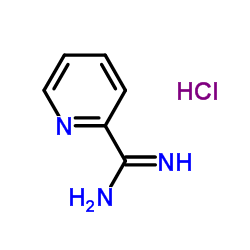
Picolinimidamide hydrochloride structure
|
Common Name | Picolinimidamide hydrochloride | ||
|---|---|---|---|---|
| CAS Number | 51285-26-8 | Molecular Weight | 157.601 | |
| Density | N/A | Boiling Point | 240.7ºC at 760 mmHg | |
| Molecular Formula | C6H8ClN3 | Melting Point | 150-152°C | |
| MSDS | N/A | Flash Point | 99.4ºC | |
| Name | Picolinimidamide Hydrochloride |
|---|---|
| Synonym | More Synonyms |
| Boiling Point | 240.7ºC at 760 mmHg |
|---|---|
| Melting Point | 150-152°C |
| Molecular Formula | C6H8ClN3 |
| Molecular Weight | 157.601 |
| Flash Point | 99.4ºC |
| Exact Mass | 157.040680 |
| PSA | 62.76000 |
| LogP | 1.96770 |
Synonym:2-Amidinopyridine hydrochloride2-Amidinopyridinium hydrochlorid Section 2 - COMPOSITION, INFORMATION ON INGREDIENTS
Risk Phrases: 36/37/38 Section 3 - HAZARDS IDENTIFICATION EMERGENCY OVERVIEW
Irritating to eyes, respiratory system and skin.Hygroscopic (absorbs moisture from the air). Potential Health Effects Eye: Causes eye irritation. Skin: Causes skin irritation. May be harmful if absorbed through the skin. Ingestion: May cause irritation of the digestive tract. May be harmful if swallowed. Inhalation: Causes respiratory tract irritation. May be harmful if inhaled. Chronic: Not available. Section 4 - FIRST AID MEASURES Eyes: Flush eyes with plenty of water for at least 15 minutes, occasionally lifting the upper and lower eyelids. Get medical aid. Skin: Get medical aid. Flush skin with plenty of water for at least 15 minutes while removing contaminated clothing and shoes. Ingestion: Get medical aid. Wash mouth out with water. Inhalation: Remove from exposure and move to fresh air immediately. If not breathing, give artificial respiration. If breathing is difficult, give oxygen. Get medical aid. Notes to Physician: Treat symptomatically and supportively. Section 5 - FIRE FIGHTING MEASURES General Information: As in any fire, wear a self-contained breathing apparatus in pressure-demand, MSHA/NIOSH (approved or equivalent), and full protective gear. Extinguishing Media: Use water spray, dry chemical, carbon dioxide, or chemical foam. Section 6 - ACCIDENTAL RELEASE MEASURES General Information: Use proper personal protective equipment as indicated in Section 8. Spills/Leaks: Vacuum or sweep up material and place into a suitable disposal container. Section 7 - HANDLING and STORAGE Handling: Avoid breathing dust, vapor, mist, or gas. Avoid contact with skin and eyes. Storage: Store in a cool, dry place. Store in a tightly closed container. Section 8 - EXPOSURE CONTROLS, PERSONAL PROTECTION Engineering Controls: Facilities storing or utilizing this material should be equipped with an eyewash facility and a safety shower. Use adequate ventilation to keep airborne concentrations low. Exposure Limits CAS# 51285-26-8: Personal Protective Equipment Eyes: Not available. Skin: Wear appropriate protective gloves to prevent skin exposure. Clothing: Wear appropriate protective clothing to prevent skin exposure. Respirators: Follow the OSHA respirator regulations found in 29 CFR 1910.134 or European Standard EN 149. Use a NIOSH/MSHA or European Standard EN 149 approved respirator if exposure limits are exceeded or if irritation or other symptoms are experienced. Section 9 - PHYSICAL AND CHEMICAL PROPERTIES Physical State: Solid Color: white crystalline solid Odor: Not available. pH: Not available. Vapor Pressure: Not available. Viscosity: Not available. Boiling Point: Not available. Freezing/Melting Point: 143 - 145 deg C Autoignition Temperature: Not available. Flash Point: Not available. Explosion Limits, lower: Not available. Explosion Limits, upper: Not available. Decomposition Temperature: Solubility in water: Specific Gravity/Density: Molecular Formula: C6H8ClN3 Molecular Weight: 158 Section 10 - STABILITY AND REACTIVITY Chemical Stability: Not available. Conditions to Avoid: Incompatible materials, exposure to moist air or water. Incompatibilities with Other Materials: Oxidizing agents, bases, acid chlorides. Hazardous Decomposition Products: Hydrogen chloride, chlorine, nitrogen oxides, carbon monoxide, carbon dioxide. Hazardous Polymerization: Has not been reported Section 11 - TOXICOLOGICAL INFORMATION RTECS#: CAS# 51285-26-8 unlisted. LD50/LC50: Not available. Carcinogenicity: Pyridine-2-carboximidamide hydrochloride - Not listed by ACGIH, IARC, or NTP. Section 12 - ECOLOGICAL INFORMATION Section 13 - DISPOSAL CONSIDERATIONS Dispose of in a manner consistent with federal, state, and local regulations. Section 14 - TRANSPORT INFORMATION IATA No information available. IMO No information available. RID/ADR No information available. Section 15 - REGULATORY INFORMATION European/International Regulations European Labeling in Accordance with EC Directives Hazard Symbols: XI Risk Phrases: R 36/37/38 Irritating to eyes, respiratory system and skin. Safety Phrases: S 26 In case of contact with eyes, rinse immediately with plenty of water and seek medical advice. S 37/39 Wear suitable gloves and eye/face protection. WGK (Water Danger/Protection) CAS# 51285-26-8: No information available. Canada None of the chemicals in this product are listed on the DSL/NDSL list. CAS# 51285-26-8 is not listed on Canada's Ingredient Disclosure List. US FEDERAL TSCA CAS# 51285-26-8 is not listed on the TSCA inventory. It is for research and development use only. SECTION 16 - ADDITIONAL INFORMATION N/A |
| Hazard Codes | Xi:Irritant; |
|---|---|
| Risk Phrases | R36/37/38 |
| Safety Phrases | S26-S36-S37/39 |
| HS Code | 2933399090 |
|
~72% 
Picolinimidamid... CAS#:51285-26-8 |
| Literature: Zhang, Pengtao; Yang, Xinye; Zhang, Feiran; Gabelli, Sandra B.; Wang, Renxiao; Zhang, Yihua; Bhat, Shridhar; Chen, Xiaochun; Furlani, Manuel; Amzel, L. Mario; Liu, Jun O.; Ma, Dawei Bioorganic and Medicinal Chemistry, 2013 , vol. 21, # 9 p. 2600 - 2617 |
|
~% 
Picolinimidamid... CAS#:51285-26-8 |
| Literature: Huixia, Xu; Yan, Yue; Litao, Qu; Yuying, Hao; Hua, Wang; Liuqing, Chen; Bingshe, Xu Dyes and Pigments, 2013 , vol. 99, # 1 p. 67 - 73 |
|
~% 
Picolinimidamid... CAS#:51285-26-8 |
| Literature: PHARMACIA CORPORATION Patent: WO2005/40133 A1, 2005 ; Location in patent: Page/Page column 126 ; WO 2005/040133 A1 |
|
~% 
Picolinimidamid... CAS#:51285-26-8 |
| Literature: BAYER CROPSCIENCE AG Patent: WO2005/79798 A1, 2005 ; Location in patent: Page/Page column 147 ; |
| Precursor 4 | |
|---|---|
| DownStream 10 | |
| HS Code | 2933399090 |
|---|---|
| Summary | 2933399090. other compounds containing an unfused pyridine ring (whether or not hydrogenated) in the structure. VAT:17.0%. Tax rebate rate:13.0%. . MFN tariff:6.5%. General tariff:20.0% |
| 2-Pyridinecarboximidamide, hydrochloride (1:1) |
| Pyridine-2-carboximidamide hydrochloride (1:1) |
| MFCD00052271 |
| pyridine-2-carboximidamide,hydrochloride |
| Picolinimidamide hydrochloride |
| Pyridine-2-carboximidamide hydrochloride |
| Pyridin-2-carboximidamidhydrochlorid |
| 2-Pyridinecarboximidamide hydrochloride (1:1) |
| Pyridine-2-carboximidamide chlorhydrate |
| 2-Amidinopyridinium chloride |
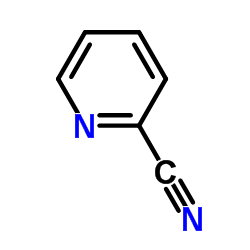
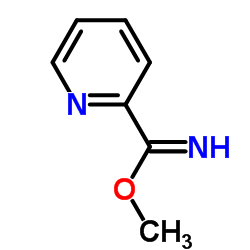
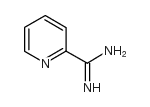
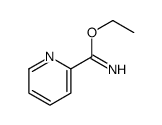
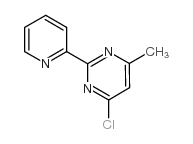 CAS#:77168-31-1
CAS#:77168-31-1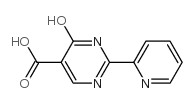 CAS#:56406-45-2
CAS#:56406-45-2 CAS#:55417-80-6
CAS#:55417-80-6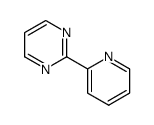 CAS#:10198-83-1
CAS#:10198-83-1 CAS#:338404-77-6
CAS#:338404-77-6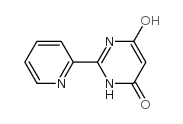 CAS#:10198-74-0
CAS#:10198-74-0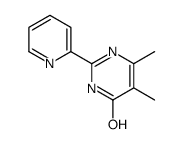 CAS#:204394-52-5
CAS#:204394-52-5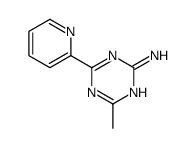 CAS#:657411-85-3
CAS#:657411-85-3![N-[amino(pyridin-2-yl)methylidene]-5-ethoxy-2-phenyl-1,3-oxazole-4-carboxamide structure](https://image.chemsrc.com/caspic/222/88584-28-5.png) CAS#:88584-28-5
CAS#:88584-28-5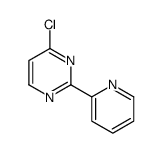 CAS#:97603-38-8
CAS#:97603-38-8
